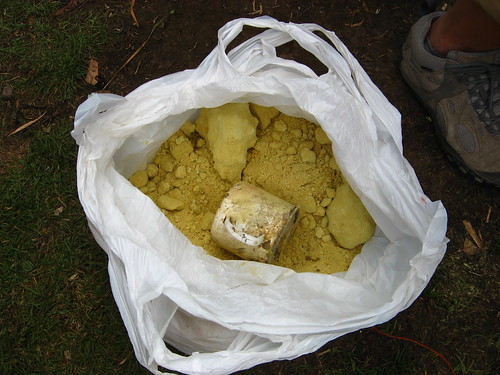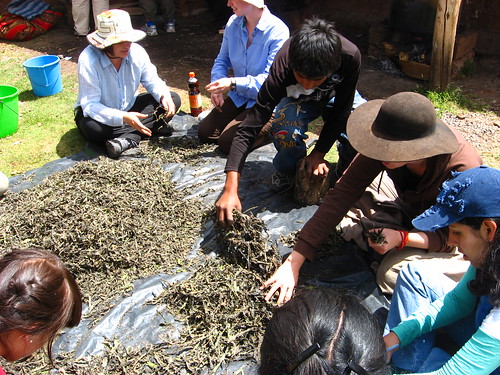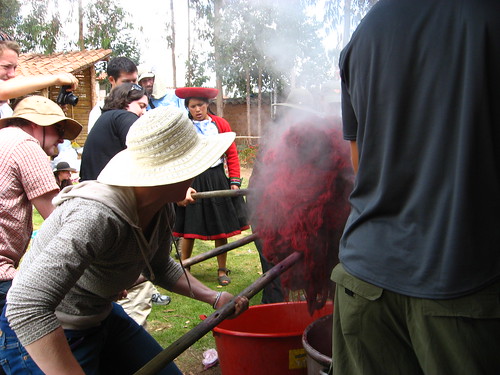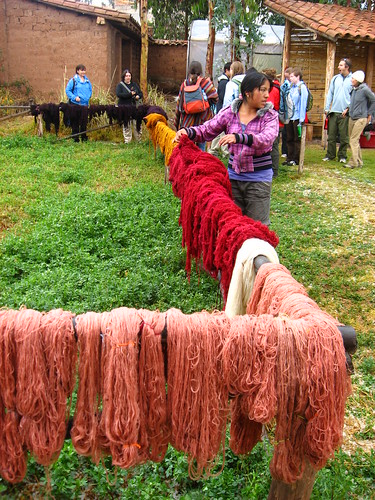
The workshop today was the children of the weavers, a group of biology & botany students from Washington University in Oregon, myself, and Clara. Nilda and the weavers oversaw the day’s proceedings and directed what was to be done in what order. Dyeing in Peru is an all-in-one process (ie. the yarn is mordanted and dyed at once, and the dyestuff is cooked with the yarn). First was the preparation of the dyestuffs and heating the water with the mordant in it.

The leaves needed their stems removed, the plant with fungi and the woody stems had to be chopped into little pieces, the cochineal ground to a powder, the flowers removed from their stems, ect. So once the dyestuff was prepped, it went into the pot and the quantity of yarn allocated for that dye went in with it. It cooked until it looked like it was the right color (no specific timing). As it cooked, if it looked not to be the right color, the modification was just tossed into the pot and then you stirred frantically. So, if it needed to be more… red maybe? You added vinegar to the cochineal and stirred. If the yellow was too yellow and needed to be more gold, a bucket of red dye water from one of the cochineal pots was poured into the pot and you stirred frantically. They removed the pot from the wood stove and pulled a bucket of dye water out of the vat when they wanted to add the copper modifier. The copper was added to that small bucket, stirred it in until dissolved, and then poured it into the pot and then you stir like crazy (you stir with large sticks, btw, because these pots could cook a small person). Then the pot is put back on the heat. Once it’s cooked enough, the pot is taken off the wood stove, and a massive group of people hoist the yarn out of the pot with the large sticks, hold it there to drip, and then drop it into a large tub to be set aside and sorted later.


Then the dye water is used for an exhaust vat or its color is modified for another color entirely. I later ended up going through the red cochineal and the purple cochineal vats, sorting yarn (my hands are now various shades of orange and purple). Once the skeins were separated, they were laid on the wooden fence and sorted by what type of yarn they were. Once things calm down a bit and the yarn is sufficiently cool, it is then rinsed out.

During the day there were a few very interesting things that went on. The first is I ended up giving a mini science lesson on the chemistry of natural dyeing to the biology/botany students—why they use protein based fibers, what the chemical names of the mordants were and what they basically do, why you use them, how the colors change based on PH, dyes I use in the states, ect. They were absolutely fascinated and I was having a great time. It was nice to feel helpful, and I always love talking to scientists about dyeing because they come at it from such a different (but awesome) perspective. The second interesting thing is they served a 3 course lunch for everybody… It began with a delicious broth based barley and veggie soup, dressed with cilantro. There was toasted barley and corn on the table for snacking and spicy home-made salsa. Then the second course which included: a purred bean dish that had the consistency of hummus, a veggie dish of swiss chard, potato, vinegars and spices that was AMAZING, a cooked salad of lima beans, carrots, with peeled tomatoes, fresh onions, and cubed cheese, boiled corn and potatoes and lima beans (a staple), and fried corn flour biscuits with peppers and cheese. Then the third course, seasoned and roasted cuy (which tastes like duck btw). To finish it off, they served Matte de Coca tea. I WAS SO FULL (Estoy muy satisfecha). I helped serve, because they needed it and ate in between helping. People wanted to know what things were (which I felt special when I knew). The third and maybe strangest/coolest (figuratively and literally) thing that happened today, was that, after lunch, it hailed on us!!! This is very strange weather here. We all had to duck under the awnings to seek shelter and keep working. It hailed for almost 45min. The children were running around, throwing showballs at each other (they’d probably never seen such a thing before!) So we all finished out the day with wet pants and shoes….

I left around 4pm, taking a super crowded taxi back to Cusco (2 ppl in the front passenger seat, 4 in the back seat, and 2 in back of the hatchback). Indira (one of the women from the CTTC, who is in charge of organizing dye workshops) and I went to the grocery store on our way home. And yet I don’t have it in me to cook this evening after the lunch I had!! Best things about this evening? Hot showers and a brand new archeologist apt. mate Adrienne!!!

This comment has been removed by the author.
ReplyDelete